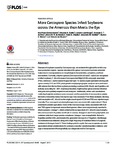Please use this identifier to cite or link to this item:
http://www.alice.cnptia.embrapa.br/alice/handle/doc/1024076| Title: | More Cercospora species infect soybeans across the Americas than meets the eye. |
| Authors: | SOARES, A. P. G.  GUILLIN, E. A.   BORGES, L. L.   SILVA, A. C. T. da   ALMEIDA, A. M. R. de   GRIJALBA, P. E.   GOTTLIEB, A. M.   BLUHM, B. H.   OLIVEIRA, L. O. de   |
| Affiliation: | ANA PAULA GOMES SOARES, UFV; EDUARDO A. GUILLIN, INTA; LEANDRO LUIZ BORGES, UFV; Amanda C. T. da Silva, UFV; ALVARO MANUEL RODRIGUES ALMEIDA, CNPSO; PABLO E. GRIJALBA, Universidad de Buenos Aires; ALEXANDRA M. GOTTLIEB, CONICET; BURTON H. BLUHM, University of Arkansas; LUIZ ORLANDO DE OLIVEIRA, UFV. |
| Date Issued: | 2015 |
| Citation: | Plos One, v. 10, n. 8, e0133495, Aug. 2015. |
| Description: | Diseases of soybean caused by Cercospora spp. are endemic throughout the world's soybean production regions. Species diversity in the genus Cercospora has been underestimated due to overdependence on morphological characteristics, symptoms, and host associations. Currently, only two species (Cercospora kikuchii and C. sojina) are recognized to infect soybean; C. kikuchii causes Cercospora leaf blight (CLB) and purple seed stain (PSS), whereas C. sojina causes frogeye leaf spot. To assess cryptic speciation among pathogens causing CLB and PSS, phylogenetic and phylogeographic analyses were performed with isolates from the top three soybean producing countries (USA, Brazil, and Argentina; collectively accounting for ~80% of global production). Eight nuclear genes and one mitochondrial gene were partially sequenced and analyzed. Additionally, amino acid substitutions conferring fungicide resistance were surveyed, and the production of cercosporin (a polyketide toxin produced bymany Cercospora spp.) was assessed. From these analyses, the longheld assumption of C. kikuchii as the single causal agent of CLB and PSS was rejected experimentally. Four cercosporin-producing lineages were uncovered with origins (about 1 Mya) predicted to predate agriculture. Some of the Cercospora spp. newly associated with CLB and PSS appear to represent undescribed species; others were not previously reported to infect soybeans. Lineage 1, which contained the ex-type strain of C. kikuchii, was monophyletic and occurred in Argentina and Brazil. In contrast, lineages 2 and 3 were polyphyletic and contained wide-host range species complexes. Lineage 4 was monophyletic, thrived in Argentina and the USA, and included the generalist Cercospora cf. flagellaris. Interlineage recombination was detected, along with a high frequency of mutations linked to fungicide resistance in lineages 2 and 3. These findings point to cryptic Cercospora species as underappreciated global considerations for soybean production and phytosanitary vigilance, and urge a reassessment of host-specificity as a diagnostic tool for Cercospora. |
| Thesagro: | Soja Doença de planta Fungo |
| NAL Thesaurus: | Soybeans Plant diseases and disorders |
| DOI: | 10.1371/journal.pone.0133495 |
| Type of Material: | Artigo de periódico |
| Access: | openAccess |
| Appears in Collections: | Artigo em periódico indexado (CNPSO)  |
Files in This Item:
| File | Description | Size | Format | |
|---|---|---|---|---|
| MoreCercosporaSpeciesInfectSoybeans.pdf | 1.27 MB | Adobe PDF |  View/Open |









